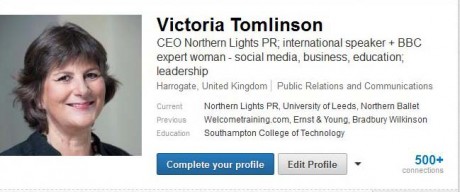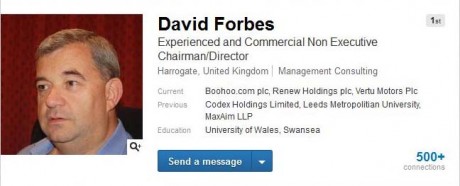Director LinkedIn profiles – how to write them?
17 September 2014 By Northern Lights

Apologies if some of the links in this blog post do not work, we have transferred this blog to the Next-Up website from our old Northern Lights PR website.
Writing a LinkedIn profile for a chief executive or a director can be surprisingly difficult. While you want some personal information, it generally should convey passion and commitment for their company or organisation. And take care if you are actively looking for a new job – LinkedIn profiles can be a real give-away. I have teased three directors recently that I thought they were looking for new jobs: they were horrified but to an experienced eye it was easy to spot.
So what should a great director’s profile look like and include?
We have written more than 70 senior LinkedIn profiles this year and the first question I always ask is ‘what is your business trying to achieve?’ LinkedIn can help you achieve corporate objectives just as your website or social media can.
1. Translating corporate objectives to a LinkedIn profile
Thinking of the profiles we have written, here is a snapshot of some of their corporate objectives
- Credibility with government procurement
- Sell the company in five years
- Be seen as the leader of a new R&D business park
- Recruit top scientists to an advisory board
- World leader in CSR in financial services
LinkedIn can actually play a role in helping to achieve all of these – and certainly others will be researching your organisation, which could include checking out the senior team on LinkedIn. You want your future corporate financier or scientist to do their research and for it all to feel consistent and see people they want to do business with?
If we take some of the business goals above, how would they affect your personal LinkedIn profile?
- Government procurement – you might mention ‘We have built up a reputation with a number of government bodies over the last 15 years and have xyz quality accreditations’
- Recruiting to a board – include something on the lines of ‘We have created an advisory board to help us plan long term to meet customer needs and welcome discussions with scientists working in xyz to join this board’
- Selling the company – you could include a description of the company, identifying aspects which will demonstrate asset value and help to attract top corporate financiers and investors long term
2. Job title and summary are the most important areas
You don’t have to give a precise job title on LinkedIn. You may be ‘managing partner, xyz law firm’ but that will do nothing to help you or your business.
LinkedIn’s search function searches primarily on job title and summary and to some extent specialties. So you want keywords about your business included in these areas.
In my own job title, I have tried to maximise what people might be searching for as well as explaining my role. So my job title reads “CEO Northern Lights PR; international speaker + BBC expert woman – social media, business, education; leadership
And David Forbes has kindly agreed to us using his profile to show how he is using his job title to support his non-executive director portfolio.
3. Personal vs professional profile
LinkedIn was started as a recruitment tool. When you first create a profile, it gives you prompts as to the information you should upload at each stage – and inevitably is pushing you towards creating a CV which will help you get your next job.
You have to be disciplined and ignore these prompts!
What you want to be careful about is too many phrases such as ‘I have spent 20 years increasing sales and markets’; ‘I am responsible for internal communications, video production, newsletters, intranet, staff briefings ……’ and so on. This is all very internal. It’s not to say you won’t want some of this but it needs to be put into a context that feels interesting and relevant to the outside business world – not just a headhunter.
4. 100% complete profile
As a chief executive or senior director of a global organisation, you may decide that there is more to be lost than gained by having a LinkedIn profile.
There are valid reasons to say you don’t want to have a profile – but I think the tipping point has come this year when even the most senior people of the world’s biggest businesses are now saying, ‘I need a profile’. While those in large corporates often tend to be internally focused, generally there is a lot to be gained from networking – selectively.
If you decide the time has come and you do want to network, then you need your profile to be 100% complete to make LinkedIn searches effective: LinkedIn searches first only on 100% complete profiles.
At the time of writing to achieve 100% profile you need to include the following information
- Photo
- Two previous jobs
- A summary
- Education
- Industry and postal code
- A current position with description
- Two more positions
- At least 5 skills
- At least 50 connections
 When you reach All-Star, your profile is complete and you will see the dark blue image below (even though it looks as if there is still more information needed!)
When you reach All-Star, your profile is complete and you will see the dark blue image below (even though it looks as if there is still more information needed!)
5. LinkedIn photos
I am constantly surprised at the most professional of people who use holiday snaps or family studio photos for their profile photo. The photo box isn’t huge so you want people to see you – not a blob peering round your partner and four children; not you with ski helmet and goggles or lying in a bikini on the holiday yacht.
Remember who may be researching you and your company and the impression you want to make (probably friendly but professional?) and ensure that if you are going to meet in a hotel or on overseas business you can both recognise each other.
6. And if you are looking for a job?
We’ve worked with a couple of directors who wanted their profile to help them find a new job. With both, the issue was that they wanted to move into a slightly different direction from their current role, picking up on experience from earlier jobs.
Headhunters use LinkedIn widely in their initial searches for talent. So a profile needs to include the keywords that they may be searching on. But …… senior people (and even junior managers) need to look committed to and passionate about their current business?
So to position yourself for future jobs, you need to weave the relevant, past experience that you want to highlight into your current role and profile.
7. Making connections
The final bit to think about when setting up, is who and how you connect with others.
Our own recommendations are
- Connect with people you want to do business with
- Don’t accept invitations from all and sundry – you want to build a network of known and trusted people
- Do write a personal invitation when asking to connect – and maybe include something about what you are trying to do as a business ‘I am keen to build our connections in corporate finance as we are looking to float in a few years – it struck me we might be able to have some useful discussions?’
It is entirely understandable if you feel uncomfortable about having a profile or feel that it is only for junior people wanting a job. But the world is changing rapidly – a number of the people we have helped have been surprising. I thought it would be another year or two before they came around.
How long did it take you to get an email address – now it looks very odd for someone not to have one at all. So it is rapidly becoming for LinkedIn. People expect to be able to search and get a feel for a business and its people through LinnkedIn profiles.
If you want help in making the leap to understand more, write your profile – or your colleagues’ – we promise to make it painless and professional – for you and your company!
Contact us





